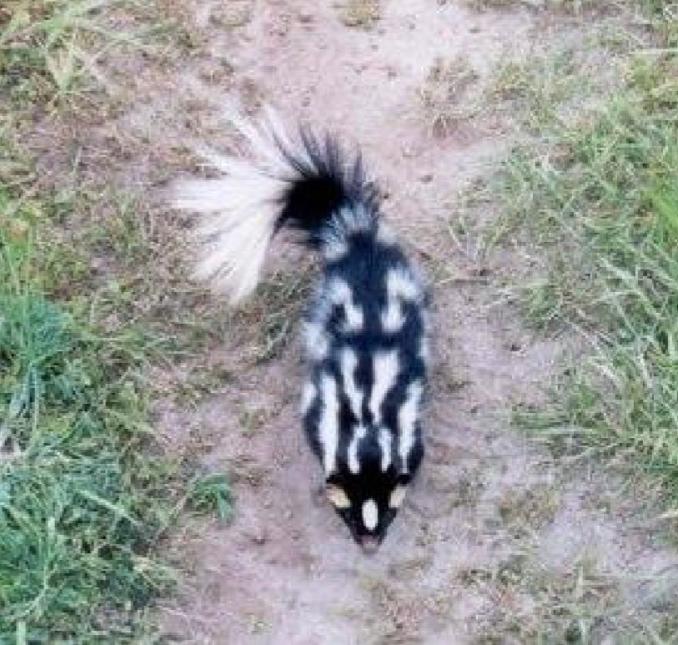Low
The population of western spotted skunk in Washington is unknown. There is inadequate information on the current status and distribution of this species in much of its range in western and southeastern Washington. The increased occurrence of opossums and loss and fragmentation of forest habitats due to urban and agricultural development may explain the apparent substantial decline of verified occurrences in the Puget Trough since the 1970s.
Description and Range
Physical description
The western spotted skunk is a small to mid-sized member of the skunk family (Mephitidae) and the smallest of the four North American skunks (1 to 4 pounds).
Ecology and life history
Western spotted skunks are associated with habitats that have dense ground cover, dense understory vegetation, burrows of other species, rocky outcrops, and woody structures, such as logs, snags, stumps, log and brush piles. These features are important as resting, denning and foraging sites and are found in a variety of land cover types including conifer forests, riparian areas, thickets and brushy habitats, and farmlands.
Western spotted skunks generally occur from sea level to 1,970 feet in elevation in the Olympic Mountains and occasionally up to 2,950 feet in the Cascade Mountains. In southeastern Washington, this species uses rocky outcrops, brushy habitats, and riparian areas, up to 1,970 feet in elevation.
The bulk of the diet is made up of small mammals and insects, but this omnivore will also eat carrion, berries, fruit, birds, bird eggs, reptiles, and amphibians.
This species is nocturnally active.
Great horned owls, bobcats, and domestic dogs and cats are documented predators of western spotted skunks. Human-created causes, such as vehicle collisions, trapping, and pest control, may be the prevalent sources of mortality in many populations.
Geographic range
The range of western spotted skunks includes much of western Washington from the western Cascade Mountain foothills to the coast; they also occur in the Blue Mountains in southeastern Washington. Population size in the Puget Trough is unknown, but the few recent reports suggest a substantial population decline has occurred there. Data from numerous recent carnivore surveys on the Olympic Peninsula indicate that western spotted skunks continue to be widespread and common there. The current status and trend in southeastern Washington are also poorly known.
For maps of world-wide distribution and other species’ information, check out NatureServe Explorerand the International Union for Conservation of Nature Red List.
Climate vulnerability
Sensitivity to climate change
Low
There is little to no information on the sensitivity of the western spotted skunk to climate change. Overall, it appears that this species exhibits low sensitivity due to its generalist diet and ability to occupy different habitats (e.g., forested areas, riparian areas, brushy habitats, farmlands).
Exposure to climate change
- None known
Conservation
Conservation Threats and Actions Needed
- Resource information collection needs
- Threat: Information on abundance, distribution, movements, and reproduction is lacking for the central and southern Cascade Mountains, and northeastern Washington.
- Action Needed: Initiate or extend current monitoring activities into the central Cascades (especially north and south of the Interstate 90 corridor) and the southern Cascades. Surveys in northeastern Washington would also be valuable.
See the Climate vulnerability section above for information about the threats posed by climate change to this species.
Living with wildlife
Skunks are mild-tempered, mostly nocturnal, and will defend themselves only when cornered or attacked. Even when other animals or people are in close proximity, skunks will ignore the intruders unless they are disturbed.
Skunks are beneficial to farmers, gardeners, and landowners because they feed on large numbers of agricultural and garden pests. While young skunks are cute and kitten-like, they are wild animals and it is illegal to keep them as pets.
Learn more about skunks and how to avoid conflicts.
Resources
References
Carey, A. B., and J. E. Kershner. 1996. Spilogale gracilis in upland forests of western Washington and Oregon. Northwestern Naturalist 77:29–34.
Rosatte, R. and S. Lariviere. 2003. Skunks. Pages 692-707 in G. A. Feldhamer, B. C. Thompson, and J. A. Chapman, editors. Wild mammals of North America: biology, management and conservation, 2nd edition. Johns Hopkins University Press, Baltimore, Maryland.
Verts, B. J., L. N. Carraway, and A. Kinlaw. 2001. Spilogale gracilis. Mammalian Species 674: 1-10.
WDFW publications
Other resources
